When I learnt that we had to overnight on a river boat in the jungle of Central Kalimantan, eight persons sharing one bathroom, that put up a bit of struggle in me.
Voice inside: You are there to see the endangered orangutans that are only found in Borneo and Sumatra!
Yeah, I saw those in the zoo – our beloved Ah Meng and her clan. And the rainforest is so hot, very humid and those blood sucking flies love me. Call me shallow.
I survived (like a big deal) two days of trekking into the dense jungle where we crossed paths with orang utans, proboscis, macaques, wild boars and others wildlife in the animal kingdom, and a night with few sweaty humans (who didn’t take a shower :P), all sleeping side by side on mattresses in mosquito nets on the upper deck of the klotok.
You know what? I experienced a trip of a lifetime, embracing nature with no network coverage and city bustle but exotic and endangered species in their natural habitats in the wilderness of Borneo, the oldest rainforest in the world.
Klok… tok… tok… tok… There goes the motor engine of a klotok. It took us about 2 hours boat ride from Port Kumai to Pasalat Camp first for the Carbon Offsetting program to plant a tree at Tanjung Putin National Park!
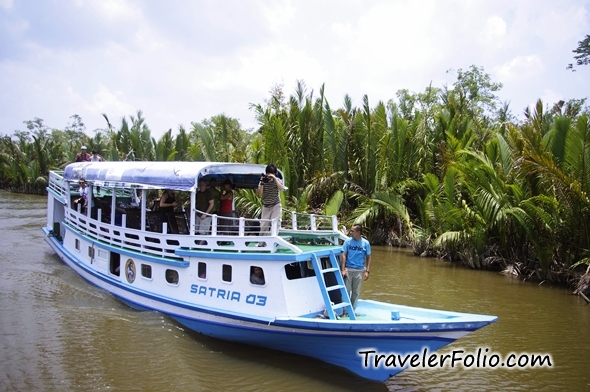
The World Famous Tanjung Puting National Park
Designated as a UNESCO Biosphere Reserve that is as big as the size of Bali, Tanjung Puting National Park is home to the largest wild orangutan population in the world – the endangered Bornean orangutans. Yet, the protected national park is constantly facing major threats from illegal logging, illegal mining, poaching, large-scale deforestation for lucrative palm oil plantations. 65% of the primary forest is degraded, resulting in the loss of natural habitat that poses a serious threat to the wildlife at the park.
In hoping to raise the awareness of the importance of conserving the Borneo rainforest and the orangutan population that is on the verge of extinction in the next decade, one of the ways is to promote ecotourism that provides alternative economic benefits to the local communities and educate environmental responsibility. So now, you see more boat tours operated by various local tour companies at Tanjung Puting National Park.
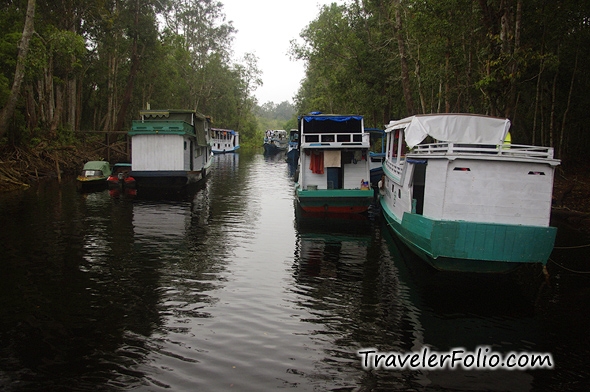
Tree planting at Pasalat Camp
We picked the trees to plant at the camp. The program is designed to let visitors do their small part in park conservation, growing trees that provide the future food source for orangutans and to offset the carbon footprint resulted from the transports that take them to the park.
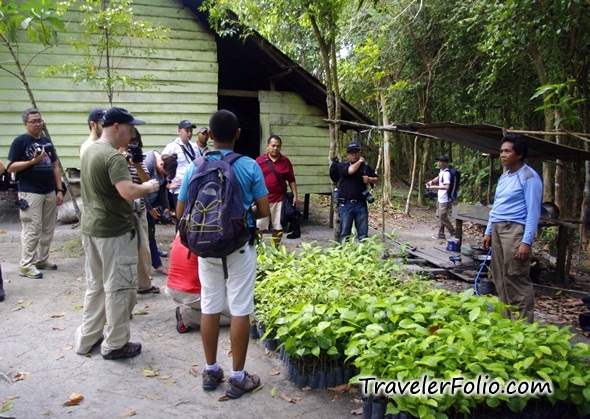
I picked a sandalwood tree! Why sandalwood? It’s auspicious! LOL
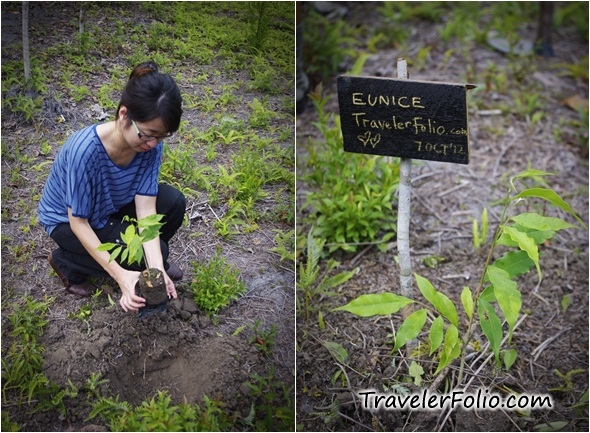
Camp Leakey
Dr. Biruté Mary Galdikas, the founder and president of OFI (Orangutan Foundation International), began her research career on the study of orangutans in their natural habitat at Camp Leakey which was set up as the first research centre at Tanjung Puting Reserve in 1971. For four decades, Dr Galdikas has devoted her time and efforts to save the orangutans of Indonesian Borneo and now she is the world renowned expert on orangutan behaviour.
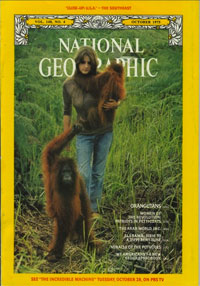
Galdikas wrote on the cover article of National Geographic in Oct 1975. She brought the plight of the orangutans to world’s attention.
Frederick Galdikas is the ‘jungle boy’ of Borneo, the son of Dr Galdikas. He grew up in Camp Leakey and has the innate ability to understand the feelings of orangutans. In other words, he is a close friend of orangutans, if not the best! Now Frederick is endeavouring to rescue orangutans from various threats in Indonesian Borneo.

If I got it right, this female orangutan is the mother of Tom, the King orangutan of Camp Leakey. When Frederick came along, she held his hand affectionately like he is part of her family! It was such heartwarming and thought provoking moment that set me thinking why some people would bear to destroy the forest homes of the orangutans and kill them.

Camp Leakey is the base for scientists, staff, students and park rangers to conduct research works involving orangutan, proboscis monkey, leaf-eating monkey, gibbon and river system ecology. It is the site of the longest continuous study of any wild mammal in the world made known by Dr Galdikas.
At Camp Leakey Information Center of Orangutan, there are documents on orangutans and wildlife at the park and exhibits to educate visitors about the endangered species. The walls are adorned with photos of family trees of orangutans, each with name labels of the King, his parents, wives and children!

Everyone was waiting for Tom, the King of Camp Leakey at the feeding area but he didn’t appear that day. His family was there enjoying bananas in front of all the keen photographers!

A mother orangutan with her baby, grabbing two bunches of bananas and moving towards a tree to climb.
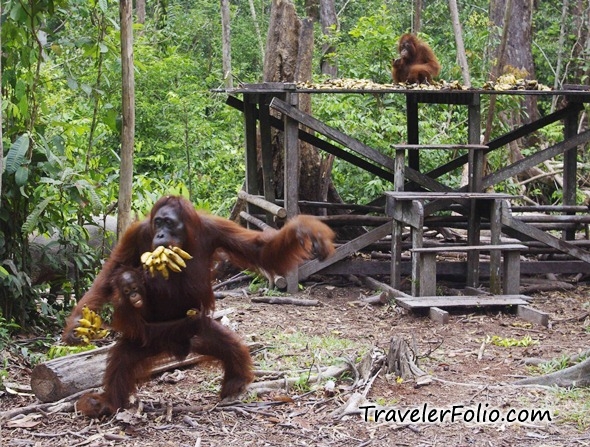
While we were hoping that Tom would come to the feeding area, a gibbon suddenly moved swiftly across the feeding area and grabbed some food.
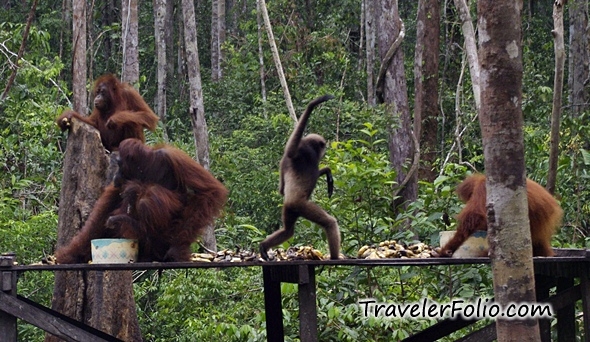
Many times we crossed the path of an orangutan in the forest. Orangutans may appear to be tame but they are wild and strong animals so we do not move close to them. When they move towards us, we step back. The park rangers are there to guide the visitors.

Visitor signboard at Camp Leakey.
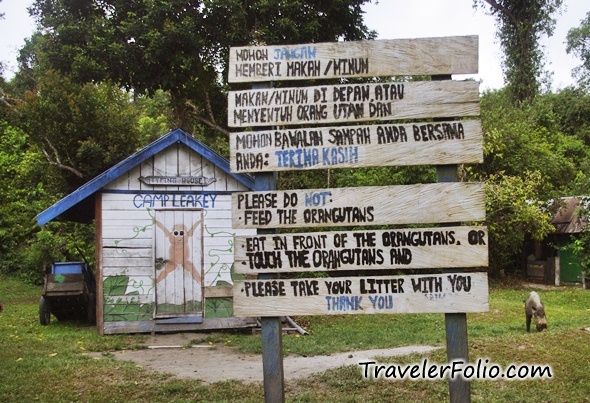
The boardwalk into Camp Leakey.

For two days, we stopped by two other camps to watch the orangutans during feeding time at Pondok Tanggui rehabilitation center and Tanjung Harapan and Observation.
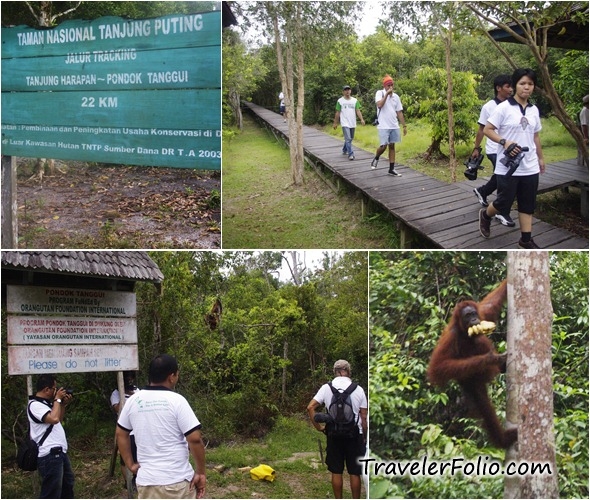
The orangutans are in their natural habitats. There is no border between visitors and the orangutans. Many times we were observing these endangered mammals at a close range yet keeping a safe distance with park rangers around us.
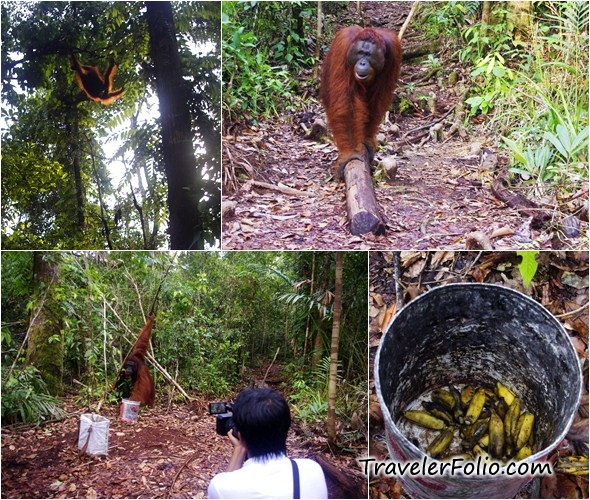
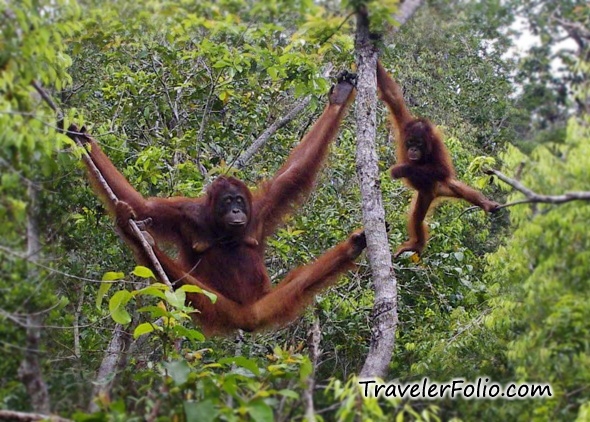
Look at this huge guy with cheek pads. He is King Doyok. An adult male orangutan with large cheek pads are generally more attractive to the females. Adult males are intolerant of each other so when two cheek-padded males meet a sexually receptive female, they will fight for her. A king orangutan claims its territory within 3km in the jungle.
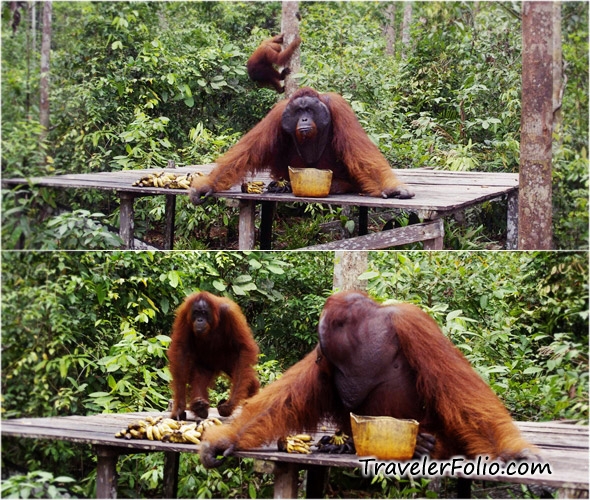
#Likeaboss, King Doyok was feeding on lot of bananas while looking back at us with his sharp eyes. He appears to be a very smart and strong fellow.
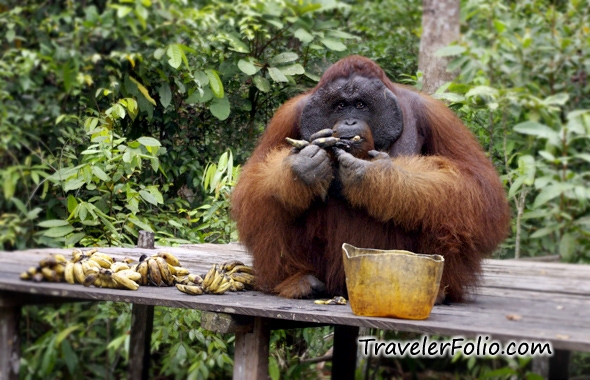
While everyone was taking photos of King Doyok, he suddenly got down from the feeding platform and moved towards us.
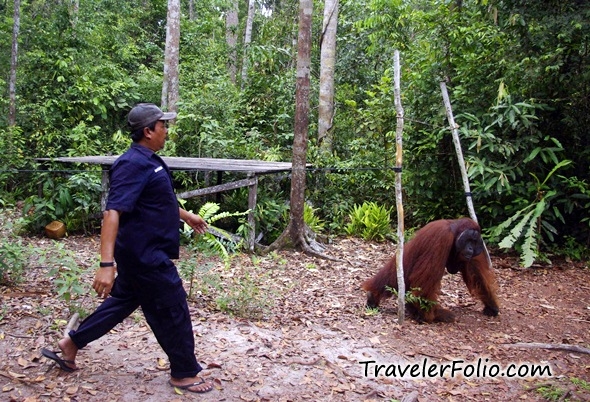
The park ranger told the visitors to step back. The King intimidated us!
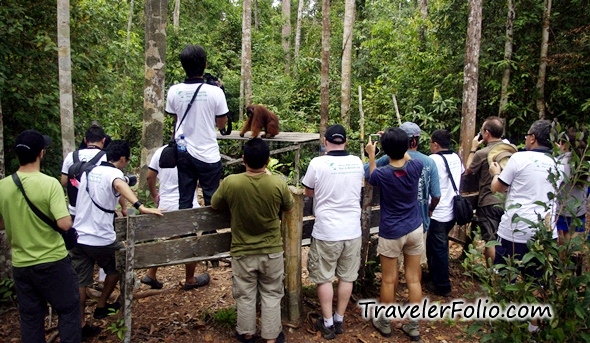
Everyone loves Sweet Hope, the aspiring model. She is not shy and really poses for cameras! Orangutans are highly intelligent and mimic human behaviour. The locals believe that Sweet Hope learnt how to strike poses like a model from visitors who took photos at the park. Look into her soulful eyes…
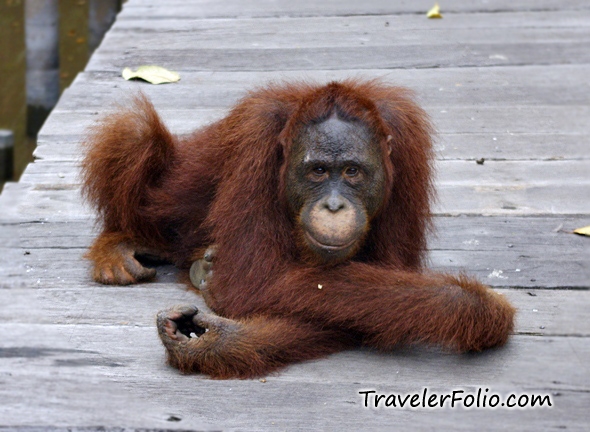
See how Sweet Hope stood up and posed like a lady! She is cute. She came to the dock in the morning where our klotoks were parked. Some of us just woke up and she seemed to welcome us. Remember we were visitors entering into the world of orangutans? A friendly host indeed.
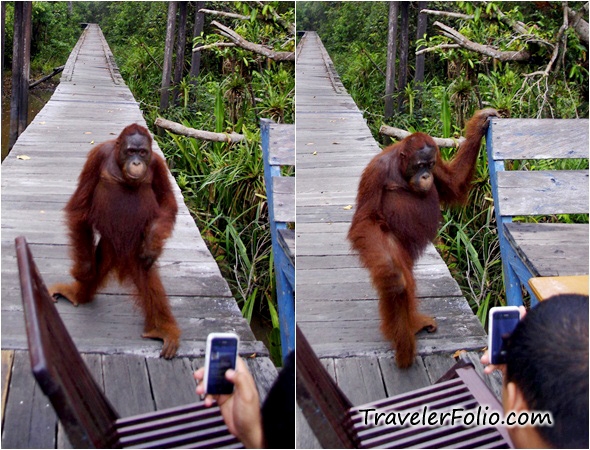
Sweet Hope never run out of pose ideas. She was the star that morning.
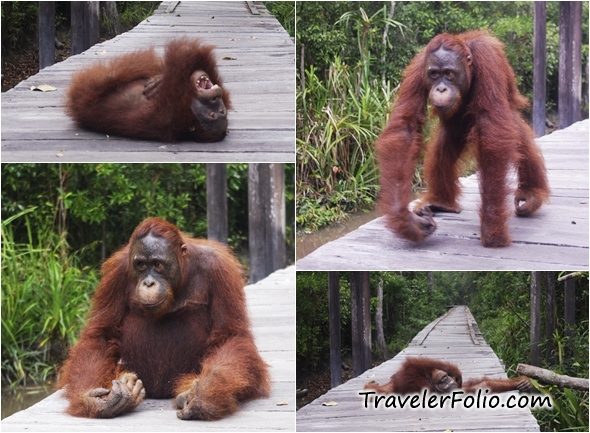

The klotok where the eight of us spent two days having warm and delicious meals prepared by the cooks, cruising along the river while enjoying the balmy breeze in the thick jungle of Central Kalimantan and sleeping soundly on mattresses at the upper deck for a night, accompanied by few fireflies and sounds of the wild.
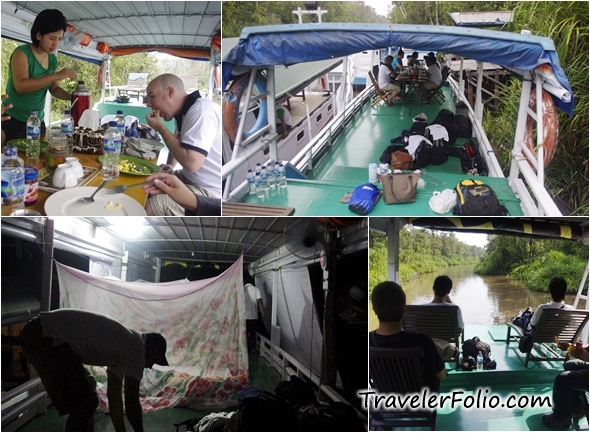
Who cooked these mouth-watering dishes of grilled fish, chilli crabs and jumbo prawns? Many of us vouched that the meals on klotok were some of the best we had throughout the 14-day Indonesia trip!
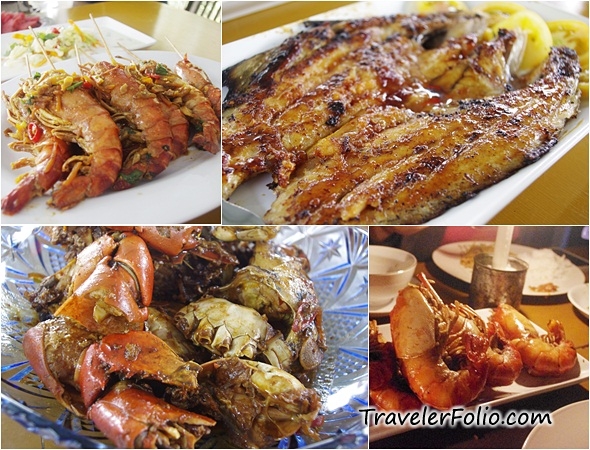
The cooks were preparing food at the kitchen on the lower deck of the klotok.
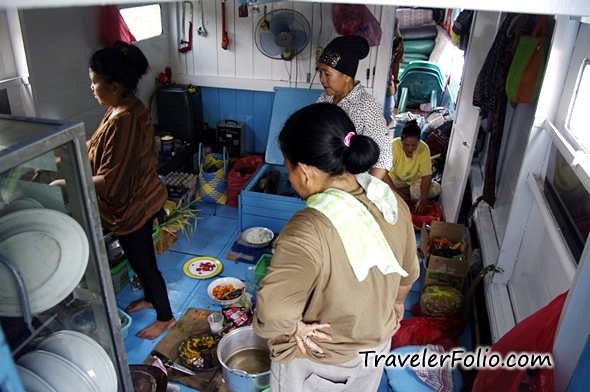
The lady was frying sambal – a spicy chilli condiment popular in Indonesia. There are many varieties of sambal using different ingredients found in different parts of Indonesia. We had sambal almost at every meal and some of us loved it so much we decided to enter the kitchen and tried to get the sambal recipe from the locals!
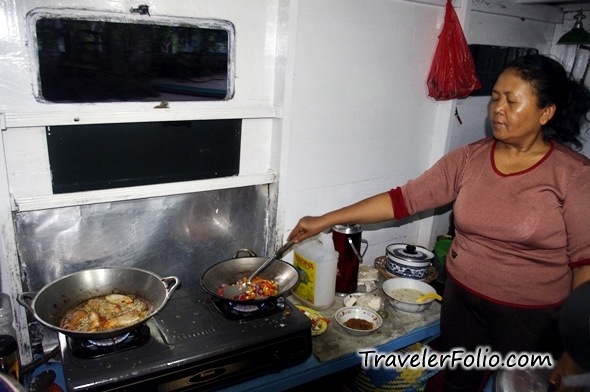
A mother and baby orangutans came close to our klotoks as we stopped by the river bank while waiting for lunch to be served.
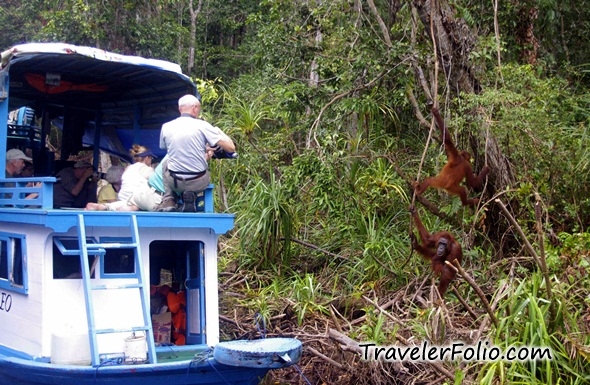
Look at these orangutans. Don’t you think they behave like human?
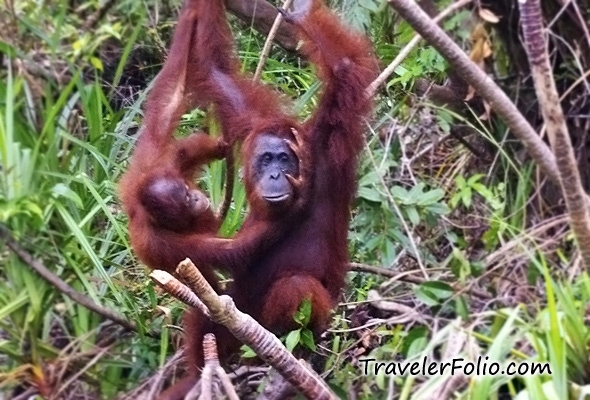
The mother orangutan suddenly swung and pulled the boat canvas. I guessed the lady on the boat panicked and quickly got hold of the canvas and tried to latch it to the boat. Apparently, the mother orangutan was up too close and personal!

Proboscis Monkeys
Residents at Tanjung Puting National Park include the endemic proboscis monkeys and leaf-eating monkeys, Gibbons, silvered leaf monkeys, sambar deer, porcupines, sun bears, clouded leopards as well as reptiles and birds such as kingfishers and hornbills.
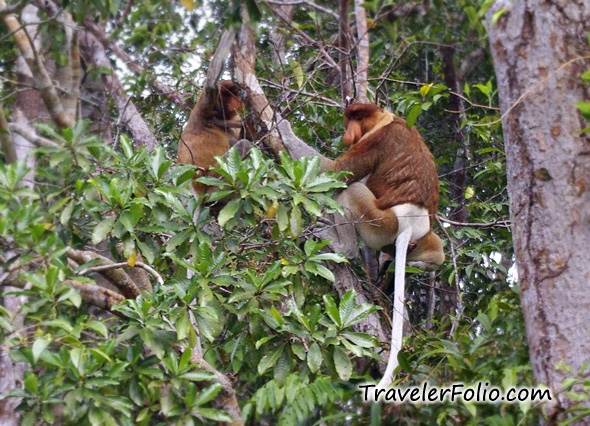
One of my favourite highlights of the cruise was to watch the bizarre-looking or rather cute-looking proboscis resting and hopping from branch to branch along the river banks. These monkeys have long nose and big belly and they are natively found in Borneo.
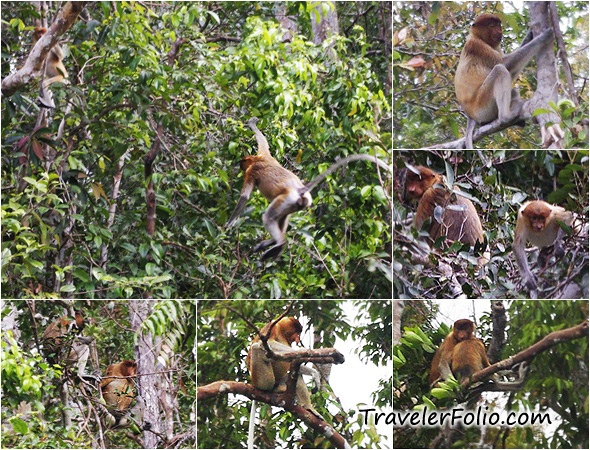
Tanjung Puting National Park is undoubtedly an incredible paradise to go primitive and enter into the mystic world of the orangutans – the gentle people of the jungle. It showcases the ‘Garden of Eden’ with an amazing array of flora and fauna.
How to get to Tanjung Puting National Park?
From Jakarta international airport, we took a 1+ hour flight via Kalstar to Iskandar airport in Pangkalan Bun, Central Kalimantan on Borneo island, Indonesia.
At Port Kumai, we started our 2 days 1 night eco-cruise tour.
Read all posts on Travel2Indonesia project.

Hi Eunice,
Such great photos! I am hoping to visit this Park in March. May I ask which tour group you traveled with?
Thank you!